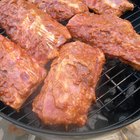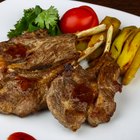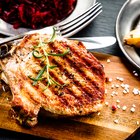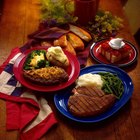Magone/iStock/GettyImages
The mild, rich flavor of pork lends itself to almost any sauce or seasoning mixture, so cooking it in an aromatic spice rub or flavorful sauce is a common practice. For example, meaty country-style ribs are often slow-roasted in a sauce to simulate the flavor of pork cooked as barbecue. It's a good option, but it does limit the versatility of your pork. They can be slow-roasted without sauce just as easily, so you can add any sauce or seasoning you choose at mealtime.
Back to the Country
The first thing you need to know about country-style ribs is that they're not ribs at all. They're usually cut from the shoulder or sirloin portions of the hog, the sections just before and just after the ribs. Country ribs cut from the shoulder are a bit chewier, while those cut from the sirloin often include a thick slice of lean loin. Some include a small piece of bone, while others are completely boneless. They're well-marbled with fat and usually contain some connective tissue, which makes them good candidates for long, slow cooking.
The Advance Preparation
Country-style ribs are generally thick and rectangular, a sort of brick-shaped pork chop. Before you cook them, take a moment to wipe away any blood spots and any bone fragments left by the butcher's saw. You can rub them with a spice mixture if you wish, and refrigerate them overnight so the flavors have time to work into the meat, but that part is optional. If you're looking for the maximum in versatility, just use salt and pepper. Browning the ribs greatly adds to their flavor as well, although it's not necessary. Just heat a skillet and sear the ribs thoroughly on every side, until they're well browned and fragrant.
The Slow Roasting
Arrange the ribs in your roasting pan or in a heavy casserole dish. If your pan doesn't have a rack, cut thick rings of onion and rest the ribs on top of those to form a sort of natural roasting rack. Pour in 1/2 cup of water, broth or cider, if you wish, to keep the air humid and prevent the ribs from losing moisture as they cook. Preheat your oven to 300 degrees Fahrenheit, cover the pan tightly with a lid or a sheet of aluminum foil, and bake the ribs for two to three hours. When they're really done -- not just cooked -- you'll be able to cut them easily with a fork.
Using the Cooked Ribs
The cooked ribs can be eaten immediately or cooled, wrapped, divided into meal-sized portions and refrigerated or frozen. When they're cooked without sauce, you can take them in any culinary direction you choose. Brush them with barbecue sauce and grill them, and you have a quick barbecue meal. They're also well suited for Asian dishes, grilled or briefly simmered in teriyaki sauce, hoisin sauce or similar flavorings. If you favor a Southwestern flavor profile, season them with chilies and cumin and shred them for tacos and burritos.
Related Articles

I Bought Smoked Pork Chops & Don't Know ...

How to Cook Boneless Country Spare Ribs

How to Cut Country Style Pork Ribs
How to Brine Pork Ribs for a BBQ

Rib Vs. Loin Grilled Lamb Chop

How to Cook With Pork Jowl

How to Bake Spare Ribs Before BBQing

The Best Way to Cook Pork Shoulder Ribs ...
Baking Buffalo Ribs in Foil

How to Boil Baby Back Ribs Before ...

How to Cook BBQ Pork Ribs Quickly
How to Cook Beef Chuck Western Style ...

How to Make Perfect Lollipop Lamb Chops

How to Quickly Cook Fork-Tender Ribs

How Many Calories Does Barbecue Pork ...

How to Heat Up Smoked Pork Ribs

How to Cook a Chuck Short Rib

How to Steam Pork Ribs

How to Cook Worcestershire Marinated ...

How to Cook Bone-In Pork Strips in the ...
References
- On Cooking: A Textbook of Culinary Fundamentals; Sarah Labensky, et al.
- Amazing Ribs: Kermit's Second Favorite Pork Chop
Writer Bio
Fred Decker is a trained chef and prolific freelance writer. In previous careers, he sold insurance and mutual funds, and was a longtime retailer. He was educated at Memorial University of Newfoundland and the Northern Alberta Institute of Technology. His articles have appeared on numerous home and garden sites including GoneOutdoors, TheNest and eHow.